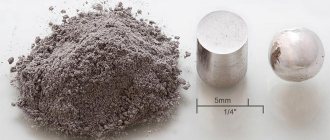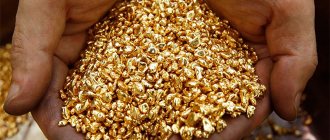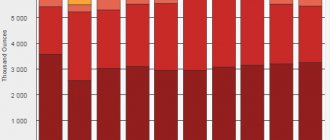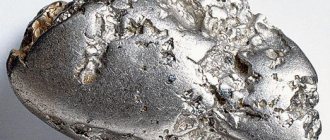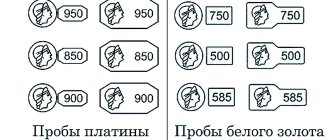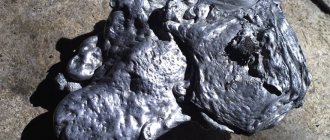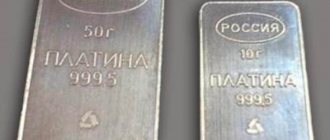Platinum
- mineral, natural Pt from the platinum group of the class of native elements, usually contains Pd, Ir, Fe, Ni. Pure platinum is very rare; most samples are represented by the ferrous variety (polyxene), and often by intermetallic compounds: isoferroplatinum (Pt,Fe)3Fe and tetraferroplatinum (Pt,Fe)Fe. Platinum, represented by polyxene, is the most common mineral of the platinum subgroup in the earth's crust.
- Structure
- Properties
- Reserves and production
- Origin
- Application
- Classification
- Physical properties
- Optical properties
- Crystallographic properties
See also:
Ice
— structure and physical properties
PROPERTIES
The color of polyxene ranges from silver-white to steel-black. The dash is metallic steel gray. The shine is typical metallic. The reflectivity in polished sections is high - 65-70. Hardness is 4-4.5, for varieties rich in iridium - up to 6-7. It has malleability. The fracture is hooked. Cleavage is usually absent. Ud. weight 15-19. A connection between the reduced specific gravity and the presence of voids occupied by natural gases, as well as inclusions of foreign minerals, has been noted. It is magnetic and paramagnetic. Conducts electricity well. Platinum is one of the most inert metals. It is insoluble in acids and alkalis, with the exception of aqua regia. Platinum also reacts directly with bromine, dissolving in it.
When heated, platinum becomes more reactive. It reacts with peroxides, and upon contact with atmospheric oxygen, with alkalis. A thin platinum wire burns in fluorine, releasing a large amount of heat. Reactions with other non-metals (chlorine, sulfur, phosphorus) occur less actively. When heated more strongly, platinum reacts with carbon and silicon, forming solid solutions, similar to the iron group metals.
Crystallographic characteristics
system ; hexaoctahedral c. With. 3L44L36L29PC. Space group Fm3m (O5h). a0 = 3.9158. a0 = 3.924 A (pure Pt), 3.831 A (pure Ir), Z = 4
The crystal structure is close-packed cubic - atoms at the sites of a face-centered cubic lattice (Cu type).
The appearance of crystals. In combinations of faces, in addition to the dominant form {100}, {110}, {210}, {310} and some others are observed. Of the twins, twins of germination along (100) and fusion along (111) are predominantly developed. Polyxene crystals of skeletal development are known.
RESERVES AND PRODUCTION
Platinum is one of the rarest metals: its average content in the earth's crust (clarke) is 5·10−7% by mass. Even the so-called native platinum is an alloy containing from 75 to 92 percent platinum, up to 20 percent iron, as well as iridium, palladium, rhodium, osmium, and less often copper and nickel.
The world's proven reserves of platinum group metals amount to about 80,000 tons and are distributed mainly between South Africa (87.5%), Russia (8.3%) and the USA (2.5%).
In Russia, the main deposits of platinum group metals are: Oktyabrskoye, Talnakhskoye and Norilsk-1 sulfide-copper-nickel in the Krasnoyarsk Territory in the Norilsk region (more than 99% of explored and more than 94% of estimated Russian reserves), Fedorova Tundra (Bolshoi Ikhtegipakhk site) sulfide- copper-nickel in the Murmansk region, as well as alluvial deposits Konder in the Khabarovsk Territory, Levtyrinyvayam in the Kamchatka Territory, the Lobva and Vyisko-Isovskoye rivers in the Sverdlovsk Region. The largest platinum nugget found in Russia is the “Ural Giant” weighing 7860.5g, discovered in 1904. at the Isovsky mine.
Native platinum is mined at mines; alluvial platinum deposits are less rich, which are explored mainly by the method of spot sampling.
The production of platinum in powder form began in 1805 by the English scientist W. H. Wollaston from South American ore. Today, platinum is obtained from a concentrate of platinum metals. The concentrate is dissolved in aqua regia, after which ethanol and sugar syrup are added to remove excess HNO3. In this case, iridium and palladium are reduced to Ir3+ and Pd2+. The subsequent addition of ammonium chloride produces ammonium hexachloroplatinate(IV) (NH4)2PtCl6. The dried sediment is calcined at 800-1000 °C. The spongy platinum thus obtained is subjected to further purification by repeated dissolution in aqua regia, precipitation of (NH4)2PtCl6 and calcination of the residue. The purified sponge platinum is then melted into ingots. When reducing solutions of platinum salts by chemical or electrochemical methods, finely dispersed platinum is obtained - platinum black.
Production
Until 1748, platinum was mined and produced only in America and was not known in the Old World.
When platinum began to be imported to Europe, its price was half that of silver. Jewelers very quickly discovered that platinum alloys well with gold, and since the density of platinum is higher than that of gold, minor additions of silver made it possible to produce fakes that could not be distinguished from gold items. This kind of counterfeit became so widespread that the Spanish king ordered the import of platinum to be stopped and the remaining reserves to be drowned in the sea. This law lasted until 1778. After the law was repealed, there was little demand for platinum; it was used mainly to create chemical equipment, devices and as catalysts. The platinum mined in America was sufficient for these purposes. There is no significant industrial production to speak of.
In 1819, platinum was first discovered in the Urals near Yekaterinburg, and in 1824 platinum placers were discovered in the Nizhny Tagil district. The explored reserves of platinum were so large that Russia almost immediately took first place in the world in the extraction of this metal. In 1828 alone, 1.5 tons of platinum were mined in Russia - more than in 100 years in South America. By the end of the 19th century, platinum was mined in Russia 40 times more than in all other countries of the world. Moreover, it was also represented by very weighty nuggets. For example, one of the nuggets found in the Urals weighed 9.6 kg.
By the middle of the 19th century. Extensive research on platinum refining was carried out in England and France. In 1859, French chemist Henri Etienne Sainte-Clair Deville first developed an industrial method for producing pure platinum ingots. From that time on, almost all the platinum mined in the Urals was bought up by English and French companies, in particular Johnson, Matthay and Co. Later, American and German companies joined in purchasing platinum from Russia.
Even after significant foreign purchases, most of the platinum mined by Russia did not find worthy use. Therefore, starting in 1828, at the proposal of the Minister of Finance Yegor Kankrin, platinum coins in denominations of 3.6 and 12 rubles began to be issued in Russia. At the same time, the 12-ruble platinum coin had a mass of 41.41 g, and the ruble silver coin contained 18 g of pure silver. That is, in terms of metal value, platinum coins were 5.2 times more expensive than silver coins. From 1828 to 1845 1,372,000 three-ruble coins, 17,582 six-ruble and 3,303 twelve-ruble coins with a total weight of 14.7 tons were issued. The main benefit from the mining was received by the owners of the mines - the Demidovs. Estimate: in 1840 alone, 3.4 tons of platinum were mined. In 1845, at the insistence of the Minister of Finance Fyodor Vronchenko, the production of platinum coins was stopped and all of them were urgently withdrawn from circulation. The main version of such a hasty step is considered to be an increase in European prices for platinum, as a result of which the coins became more expensive than their face value. After the cessation of coinage, platinum production in Russia fell 20 times and by 1915 Russia accounted for only 95% of world platinum production. The remaining 5% was produced by Colombia. Moreover, almost all Russian platinum was exported. For example, in 1867, England bought up the entire reserve of Russian platinum - more than 16 tons.
By the end of the 19th century. Russia produced 4.5 tons of platinum per year.
Before World War I, Colombia was the second largest platinum-producing country after Russia; since the 1930s became Canada, and after World War II - South Africa.
In 1952, Colombia produced 0.75 tons of platinum, the USA - 0.88 tons, Canada - 3.75 tons, and the Union of South Africa - 7.2 tons. In the USSR, data on platinum production was classified.
In 2007, 213 tons of platinum were mined in the world, and in 2008 - 200 tons. The leaders in production were: South Africa (166.0 tons were mined in 2007, and 153.0 tons in 2008), Russia (27.0 tons). /25.0), Canada (6.2/7.2), Zimbabwe (5.3/5.6), USA (3.9/3.7), Colombia (1.4/1.7). [3]
The leader in platinum production in Russia is MMC Norilsk Nickel.
The world's proven reserves of platinum group metals amount to about 80,000 tons and are distributed mainly between South Africa (87.5%), Russia (8.3%) and the USA (2.5%).
ORIGIN
Platinum group minerals are mostly found in typical igneous deposits, genetically related to ultramafic igneous rocks. These minerals are among the last to be released in ore bodies (after silicates and oxides) at moments corresponding to the hydrothermal stage of the magmatic process. Platinum minerals poor in palladium (polyxene, platinum iridium, etc.) are found in deposits among dunites - olivine feldspar-free rocks rich in magnesia and poor in silica. Moreover, paragenetically they are extremely closely related to chrome spinels. Nickel-palladized platinum is predominantly distributed in basic igneous rocks (norites, gabbro-norites) and is usually associated with sulfides: pyrrhotite, chalcopyrite and pentlandite. Under exogenous conditions, in the process of destruction of bedrock deposits and rocks, platinum placers are formed. Most minerals of the platinum subgroup are chemically stable under these conditions. Platinum in placers occurs in the form of nuggets, flakes, plates, cakes, concretions, as well as skeletal forms and spongy secretions ranging in size from 0.05 to 5 mm, sometimes up to 12 mm. Flattened and lamellar platinum grains indicate significant removal from bedrock sources and redeposition. The range of platinum transfer in placers usually does not exceed 8 km; in spit placers it is greater. Palladite and cuprous varieties of platinum in the hypergenesis zone can be “ennobled”, losing Pd, Cu, and Ni. Cu and Ni content, according to A.G. Betekhtin, in platinum from placers can be reduced by more than 2 times compared to platinum from an indigenous source. In placers in many areas of the world, newly formed chemically pure platinum and palladium platinum in the form of sintered forms of a radial-radiant structure have been described.
Interesting Facts
- The largest platinum nugget currently existing is the “Ural Giant” weighing 7,860.5. Kept in the Diamond Fund of the Moscow Kremlin.
- In South America in the 17th century, platinum was considered “fake silver” and one day its reserves were drowned in the ocean to prevent counterfeiting.
- The world's first platinum coins were issued in Russia (see Platinum coins).
- In Isaac Asimov's short story series "I, Robot" and his other works, the positronic brains of robots are made of spongy platinum (more precisely, an alloy of platinum and iridium).
APPLICATION
Platinum compounds (mainly amminoplatinates) are used as cytostatics in the treatment of various forms of cancer. Cisplatin (cis-dichlorodiammineplatinum(II)) was the first to be introduced into clinical practice; however, more effective diammineplatinum carboxylate complexes, carboplatin and oxaliplatin, are currently used.
Platinum and its alloys are widely used in jewelry production.
The world's first platinum coins were issued and circulated in the Russian Empire from 1828 to 1845. Minting began with three-ruble coins. In 1829, “platinum duplons” (six-ruble coins) were established, and in 1830, “quadruples” (twelve-ruble coins). The following coin denominations were minted: 3, 6 and 12 rubles. 1,371,691 pieces of three-ruble coins were minted, 14,847 pieces of six-ruble coins were minted. and twelve-ruble coins - 3474 pcs.
Platinum was used in the manufacture of insignia for outstanding services: the image of V.I. Lenin on the Soviet Order of Lenin was made from platinum; The Soviet Order of Victory, the Order of Suvorov, 1st degree, and the Order of Ushakov, 1st degree, were made from it.
- Since the first quarter of the 19th century, it was used in Russia as an alloying additive for the production of high-strength steels.
- Platinum is used as a catalyst (most often in an alloy with rhodium, and also in the form of platinum black - a fine powder of platinum obtained by reducing its compounds).
- Vessels and stirrers used in the melting of optical glasses are made from platinum.
- For the manufacture of laboratory glassware (crucibles, spoons, etc.) resistant to chemicals and high heat.
- For the manufacture of permanent magnets with high coercive force and residual magnetization (an alloy of three parts of platinum and one part of cobalt PlK-78).
- Special mirrors for laser technology.
- For the manufacture of durable and stable electrical contacts in the form of alloys with iridium, for example, contacts of electromagnetic relays (alloys PLI-10, PLI-20, PLI-30).
- Galvanic coatings.
- Distillation retorts for the production of hydrofluoric acid, production of perchloric acid.
- Electrodes for the production of perchlorates, perborates, percarbonates, peroxodisulfuric acid (in fact, the use of platinum determines the entire world production of hydrogen peroxide: electrolysis of sulfuric acid - peroxodisulfuric acid - hydrolysis - distillation of hydrogen peroxide).
- Insoluble anodes in electroplating.
- Heating elements of resistance furnaces.
- Manufacturing of resistance thermometers.
- Coatings for microwave technology elements (waveguides, attenuators, resonator elements).
Platinum - Pt
| Molecular weight | 195.08 g/mol |
| origin of name | from Spanish Platina, will reduce. from plata - “silver”, i.e. silver, little silver |
| IMA status | valid, first described before 1959 (before IMA) |
Platinum for man
The scope of application of the precious metal includes the oil refining industry. Here you cannot do without catalysts containing platinum. The lion's share goes here (about half of the precious metal mined). The chemical industry uses the noble metal in the production of nitric acid.
We recommend: OSMIUM - there is no heavier metal
Platinum is indispensable in radio engineering, electrical engineering, telemechanics, and precision instrument making.
“Silver” is used in medicine. Here, surgical instruments are made from platinum alloys. There are methods for treating cancer using cis-isomers, derivatives of divalent platinum.
The activity of the Green Party has led to an increase in consumption of the “queen of metals” in the automotive industry. Tightening standards for harmful emissions into the atmosphere has led to the equipping of cars with autocatalysts.
The Russian kilogram standard is made from an alloy of platinum and iridium.
Informative: the police and casinos use platinum-coated mirrors. From the illuminated side it works like an ordinary mirror, from the shadow side it is transparent, like glass.
PHYSICAL PROPERTIES
| Mineral color | steel gray fading to dark gray |
| Stroke color | gray-white |
| Transparency | opaque |
| Shine | metal |
| Cleavage | No |
| Hardness (Mohs scale) | 4-4,5 |
| Strength | malleable |
| Kink | serrated, hooked |
| Density (measured) | 14 - 19 g/cm3 |
| Radioactivity (GRapi) | 0 |
| Magnetism | paramagnetic |
Form of being in nature
Usually observed in the form of small grains or nuggets weighing up to 8 kg. The largest nugget found in the primary deposits of the Urals weighed 427.5 g. Nuggets found in placers reached a size of 10 × 18 cm and a weight of 8–9 kg. The largest platinum nuggets displayed at the exhibition of the Diamond Fund of Russia weigh 5918.4 and 7860.5 grams. The rare small crystals are mostly cubic in shape.
Individual grains of native platinum found in ores are often grouped into small piles, sometimes forming continuous masses - nuggets.
History of metal use
Platinum was known even before our era. It was used in Ancient Egypt to make a variety of jewelry. It was also common among the Incas, but was forgotten over time. In the photo you can see platinum items discovered by archaeologists:
Only after a long time, the discovery of this substance occurred thanks to Spanish travelers who were exploring South America. Initially, it was not appreciated, as the name suggests. "Platina" translated from Spanish can be formulated as "little silver." Accordingly, platinum was valued much less than precious metals. Often it was even considered unripe gold or incorrect silver (due to its color) and was simply thrown away. It is characterized by refractoriness and high density. Therefore it was considered unsuitable for any use.
However, then an interesting property was discovered - this precious metal has the ability to easily alloy with gold. Jewelers took this into account and actively began to mix platinum into gold products, thereby reducing the cost of their production. Moreover, this was done so skillfully that it was almost impossible to detect a fake. Due to the high density of platinum, even a small volume of it increased the weight of the finished product, but this was compensated by adding a certain amount of silver to the alloy, which did not affect the color. Such fraud was nevertheless recognized, and the import of the precious metal into Europe was prohibited by law for some time.
Platinum was recognized as an independent chemical element only in the mid-eighteenth century. A thorough study of its qualities made it possible to find the first use of this metal.
The physical and operational properties of platinum, especially resistance to various influences and high density, served as the basis for making useful equipment from it. In particular, platinum retorts were successfully used to concentrate caustic sulfuric acid.
Such vessels were initially made by forging or pressing, since in those days scientific progress could not provide the necessary temperature in furnaces for melting. By the end of the nineteenth century, it was possible to melt platinum using the flame generated by the combustion of detonating gas.
Zodiac sign
- Ideal for water signs of the zodiac - Pisces and Cancer . They can wear platinum jewelry all the time. The decoration will become a suitable talisman.
- A similar decoration will also come in handy for Sagittarius . It will help him find peace of mind and achieve harmony. For Scorpio, platinum jewelry will develop intuition.
- You should be wary of metal for Gemini , Leo , as well as Aquarius and Taurus .
- Virgos can wear the product on rare occasions when they need to calm down and get rid of negative thoughts.
- Read more about each zodiac sign here .
How to determine authenticity
They offer silver or white gold under the guise of platinum.
You can determine the authenticity of a product at home:
- A product made of platinum is heavier than gold, especially silver of comparable parameters.
- Place the silver item and the sample next to it. Even high-grade silver gives off a grayish tint and “coldness.” The platinum composition has a pure warm white luster.
There are other differences between platinum and white gold:
- Platinum rings, earrings, even necklaces and bracelets are not large or massive - the metal is too expensive.
- At normal temperatures, it is not affected by hydrogen peroxide, iodine solution, or acetic acid. They will not leave marks on the surface.
- Under the flame of a candle, lighter, or household gas stove, it will heat up, but will not change in appearance. Gold may soften.
- You can hold the sample in your hands: the royal metal takes longer to heat up than gold, especially silver.
- A pawn shop worker or jeweler is guaranteed to be able to distinguish the original.
Platinum looks almost like white gold, so many are sure that they are the same thing. However, white gold is an alloy of metals, and platinum is an independent element.
Place of Birth
Large deposits of the first type are known near Nizhny Tagil in the Urals. Here, in addition to primary deposits, there are also rich eluvial and alluvial placers. Examples of deposits of the second type are the Bushveld igneous complex in South Africa and Sudbury in Canada.
In the Urals, the first discoveries of native platinum that attracted attention date back to 1819. There it was discovered as an admixture to placer gold. Independently rich platinum placers, which are world famous, were discovered later. They are common in the Middle and Northern Urals and are all spatially confined to outcrops of massifs of ultrabasic rocks (dunites and pyroxenites). Numerous small primary deposits have been established in the Nizhny Tagil dunite massif. Accumulations of native platinum (polyxene) are confined mainly to chromite ore bodies, consisting mainly of chrome spinels with an admixture of silicates (olivine and serpentine). From the heterogeneous ultramafic Konder massif in the Khabarovsk Territory, platinum crystals of cubic habit, about 1–2 cm in size, come from the edge. A large amount of palladium platinum is mined from segregation sulfide copper-nickel ores of the Norilsk group deposits (North Central Siberia). Platinum can also be extracted from late magmatic titanomagnetite ores associated with the main rocks in such deposits as, for example, Gusevogorskoye and Kachkanarskoye (Middle Urals).
An analogue of Norilsk is of great importance in the platinum mining industry - the famous Sudbury deposit in Canada, from whose copper-nickel ores platinum metals are extracted along with nickel, copper and cobalt.
